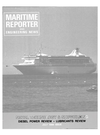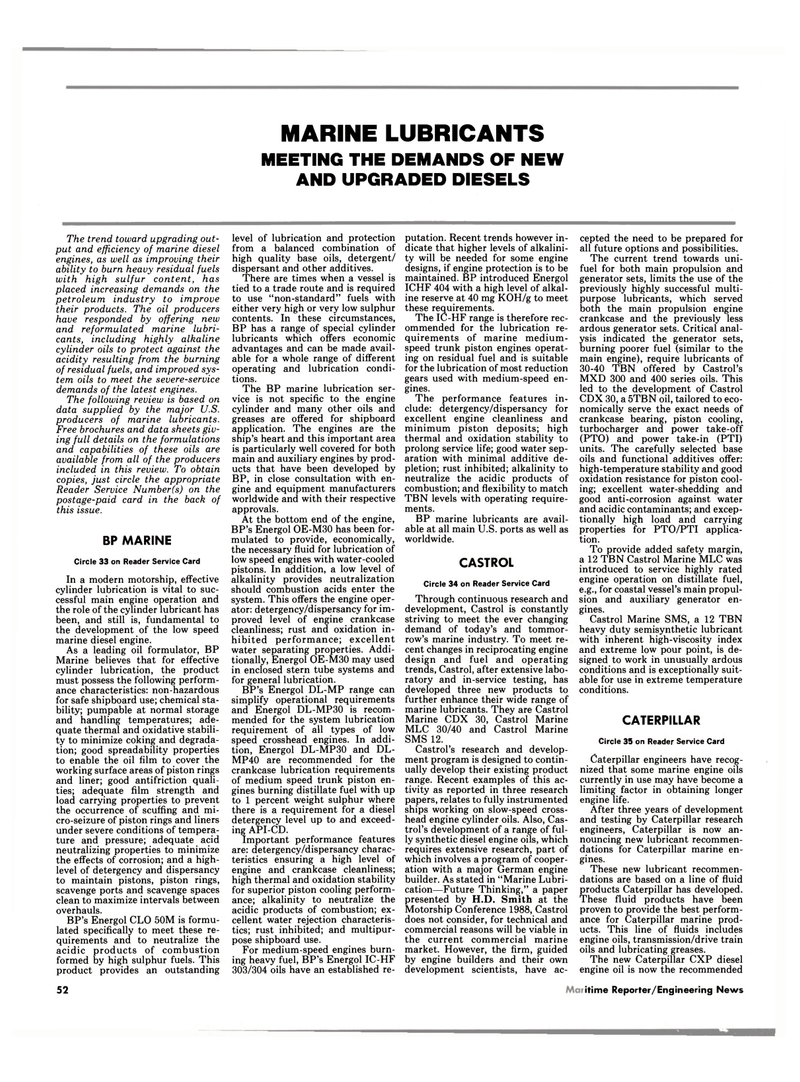
Page 40: of Maritime Reporter Magazine (July 1988)
Read this page in Pdf, Flash or Html5 edition of July 1988 Maritime Reporter Magazine
MARINE LUBRICANTS
MEETING THE DEMANDS OF NEW
AND UPGRADED DIESELS
The trend toward upgrading out- put and efficiency of marine diesel engines, as well as improving their ability to burn heavy residual fuels with high sulfur content, has placed increasing demands on the petroleum industry to improve their products. The oil producers have responded by offering new and reformulated marine lubri- cants, including highly alkaline cylinder oils to protect against the acidity resulting from the burning of residual fuels, and improved sys- tem oils to meet the severe-service demands of the latest engines.
The following review is based on data supplied by the major U.S. producers of marine lubricants.
Free brochures and data sheets giv- ing full details on the formulations and capabilities of these oils are available from all of the producers included in this review. To obtain copies, just circle the appropriate
Reader Service Number(s) on the postage-paid card in the back of this issue.
BP MARINE
Circle 33 on Reader Service Card
In a modern motorship, effective cylinder lubrication is vital to suc- cessful main engine operation and the role of the cylinder lubricant has been, and still is, fundamental to the development of the low speed marine diesel engine.
As a leading oil formulator, BP
Marine believes that for effective cylinder lubrication, the product must possess the following perform- ance characteristics: non-hazardous for safe shipboard use; chemical sta- bility; pumpable at normal storage and handling temperatures; ade- quate thermal and oxidative stabili- ty to minimize coking and degrada- tion; good spreadability properties to enable the oil film to cover the working surface areas of piston rings and liner; good antifriction quali- ties; adequate film strength and load carrying properties to prevent the occurrence of scuffing and mi- cro-seizure of piston rings and liners under severe conditions of tempera- ture and pressure; adequate acid neutralizing properties to minimize the effects of corrosion; and a high- level of detergency and dispersancy to maintain pistons, piston rings, scavenge ports and scavenge spaces clean to maximize intervals between overhauls.
BP's Energol CLO 50M is formu- lated specifically to meet these re- quirements and to neutralize the acidic products of combustion formed by high sulphur fuels. This product provides an outstanding 52 level of lubrication and protection from a balanced combination of high quality base oils, detergent/ dispersant and other additives.
There are times when a vessel is tied to a trade route and is required to use "non-standard" fuels with either very high or very low sulphur contents. In these circumstances,
BP has a range of special cylinder lubricants which offers economic advantages and can be made avail- able for a whole range of different operating and lubrication condi- tions.
The BP marine lubrication ser- vice is not specific to the engine cylinder and many other oils and greases are offered for shipboard application. The engines are the ship's heart and this important area is particularly well covered for both main and auxiliary engines by prod- ucts that have been developed by
BP, in close consultation with en- gine and equipment manufacturers worldwide and with their respective approvals.
At the bottom end of the engine,
BP's Energol OE-M30 has been for- mulated to provide, economically, the necessary fluid for lubrication of low speed engines with water-cooled pistons. In addition, a low level of alkalinity provides neutralization should combustion acids enter the system. This offers the engine oper- ator: detergency/dispersancy for im- proved level of engine crankcase cleanliness; rust and oxidation in- hibited performance; excellent water separating properties. Addi- tionally, Energol OE-M30 may used in enclosed stern tube systems and for general lubrication.
BP's Energol DL-MP range can simplify operational requirements and Energol DL-MP30 is recom- mended for the system lubrication requirement of all types of low speed crosshead engines. In addi- tion, Energol DL-MP30 and DL-
MP40 are recommended for the crankcase lubrication requirements of medium speed trunk piston en- gines burning distillate fuel with up to 1 percent weight sulphur where there is a requirement for a diesel detergency level up to and exceed- ing API-CD.
Important performance features are: detergency/dispersancy charac- teristics ensuring a high level of engine and crankcase cleanliness; high thermal and oxidation stability for superior piston cooling perform- ance; alkalinity to neutralize the acidic products of combustion; ex- cellent water rejection characteris- tics; rust inhibited; and multipur- pose shipboard use.
For medium-speed engines burn- ing heavy fuel, BP's Energol IC-HF 303/304 oils have an established re- putation. Recent trends however in- dicate that higher levels of alkalini- ty will be needed for some engine designs, if engine protection is to be maintained. BP introduced Energol
ICHF 404 with a high level of alkal- ine reserve at 40 mg KOH/g to meet these requirements.
The iC-HF range is therefore rec- ommended for the lubrication re- quirements of marine medium- speed trunk piston engines operat- ing on residual fuel and is suitable for the lubrication of most reduction gears used with medium-speed en- gines.
The performance features in- clude: detergency/dispersancy for excellent engine cleanliness and minimum piston deposits; high thermal and oxidation stability to prolong service life; good water sep- aration with minimal additive de- pletion; rust inhibited; alkalinity to neutralize the acidic products of combustion; and flexibility to match
TBN levels with operating require- ments.
BP marine lubricants are avail- able at all main U.S. ports as well as worldwide.
CASTROL
Circle 34 on Reader Service Card
Through continuous research and development, Castrol is constantly striving to meet the ever changing demand of today's and tommor- row's marine industry. To meet re- cent changes in reciprocating engine design and fuel and operating trends, Castrol, after extensive labo- ratory and in-service testing, has developed three new products to further enhance their wide range of marine lubricants. They are Castrol
Marine CDX 30, Castrol Marine
MLC 30/40 and Castrol Marine
SMS 12.
Castrol's research and develop- ment program is designed to contin- ually develop their existing product range. Recent examples of this ac- tivity as reported in three research papers, relates to fully instrumented ships working on slow-speed cross- head engine cylinder oils. Also, Cas- trol's development of a range of ful- ly synthetic diesel engine oils, which requires extensive research, part of which involves a program of cooper- ation with a major German engine builder. As stated in "Marine Lubri- cation—Future Thinking," a paper presented by H.D. Smith at the
Motorship Conference 1988, Castrol does not consider, for technical and commercial reasons will be viable in the current commercial marine market. However, the firm, guided by engine builders and their own development scientists, have ac- cepted the need to be prepared for all future options and possibilities.
The current trend towards uni- fuel for both main propulsion and generator sets, limits the use of the previously highly successful multi- purpose lubricants, which served both the main propulsion engine crankcase and the previously less ardous generator sets. Critical anal- ysis indicated the generator sets, burning poorer fuel (similar to the main engine), require lubricants of 30-40 TBN offered by Castrol's
MXD 300 and 400 series oils. This led to the development of Castrol
CDX 30, a 5TBN oil, tailored to eco- nomically serve the exact needs of crankcase bearing, piston cooling, turbocharger and power take-off (PTO) and power take-in (PTI) units. The carefully selected base oils and functional additives offer: high-temperature stability and good oxidation resistance for piston cool- ing; excellent water-shedding and good anti-corrosion against water and acidic contaminants; and excep- tionally high load and carrying properties for PTO/PTI applica- tion.
To provide added safety margin, a 12 TBN Castrol Marine MLC was introduced to service highly rated engine operation on distillate fuel, e.g., for coastal vessel's main propul- sion and auxiliary generator en- gines.
Castrol Marine SMS, a 12 TBN heavy duty semisynthetic lubricant with inherent high-viscosity index and extreme low pour point, is de- signed to work in unusually ardous conditions and is exceptionally suit- able for use in extreme temperature conditions.
CATERPILLAR
Circle 35 on Reader Service Card
Caterpillar engineers have recog- nized that some marine engine oils currently in use may have become a limiting factor in obtaining longer engine life.
After three years of development and testing by Caterpillar research engineers, Caterpillar is now an- nouncing new lubricant recommen- dations for Caterpillar marine en- gines.
These new lubricant recommen- dations are based on a line of fluid products Caterpillar has developed.
These fluid products have been proven to provide the best perform- ance for Caterpillar marine prod- ucts. This line of fluids includes engine oils, transmission/drive train oils and lubricating greases.
The new Caterpillar CXP diesel engine oil is now the recommended
Maritime Reporter/Engineering News

 39
39

 41
41
